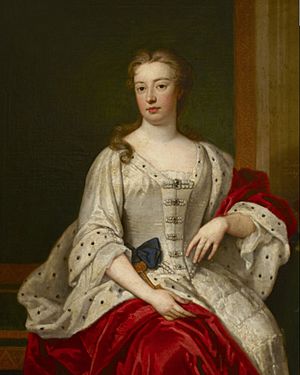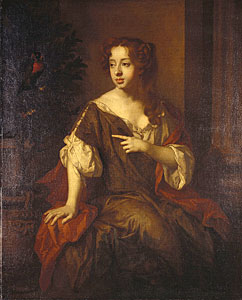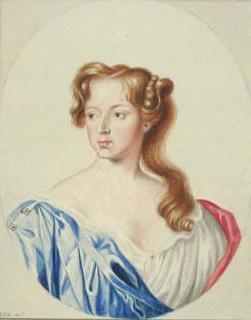Elizabeth Seymour, Duchess of Somerset facts for kids
Quick facts for kids
The Duchess of Somerset
|
|
|---|---|

Lady Elizabeth Percy (Duchess of Somerset), painted in 1713 by Godfrey Kneller (1646/9-1723); collection of Petworth House
|
|
| Born | Lady Elizabeth Percy 26 January 1667 Petworth House, Sussex, England |
| Died | 23/24 November 1722 (aged 55) Northumberland House, London, England |
| Noble family | Percy (birth) Seymour (by marriage) |
| Spouse(s) |
Henry Cavendish, Earl of Ogle
(m. 1679; died 1680)Thomas Thynne
(m. 1681; died 1682) |
| Issue |
|
| Parents |
|
| Occupation | Mistress of the Robes to Anne, Queen of Great Britain |
Elizabeth Seymour, Duchess of Somerset (born January 26, 1667 – died November 23/24, 1722) was a very important English noblewoman. She inherited a lot of land and wealth. She was also known as Baroness Percy in her own right, meaning she held that title herself, not through her husband.
She was the only child of Joceline Percy, 11th Earl of Northumberland, who was a very powerful earl. Elizabeth was a close friend of Anne, Queen of Great Britain. A writer named Jonathan Swift even wrote a poem about her, calling her "Carrots" because of her red hair.
Contents
Elizabeth's Three Marriages
Elizabeth married three times in her life. She had children only with her third husband.
Her First Marriage: Henry Cavendish
When Elizabeth was just 12 years old, she married 20-year-old Henry Cavendish, Earl of Ogle. This happened on March 27, 1679. Henry was the only son of the Duke of Newcastle.
Sadly, Henry died the very next year, in 1680. Elizabeth became a widow at only 13. Because she was so young, it's thought they did not live together as husband and wife.
Her Second Marriage: Thomas Thynne
On November 15, 1681, when Elizabeth was 14, she married Thomas Thynne of Longleat. He was known as "Tom of Ten Thousand" because he was very rich.
Tragically, Thomas Thynne died in February 1682, just a few months after their wedding. He was killed in London by three men. It was believed that a Swedish Count, Karl Johann von Königsmark, had ordered the attack because he wanted to marry Elizabeth.
For many years, some people wrongly blamed Elizabeth for his death. The men who carried out the attack were punished, but Count Königsmark was found not guilty. Elizabeth did not have any children from this marriage.
Her Third Marriage: Charles Seymour
Five months after Thomas Thynne died, Elizabeth married again. On May 30, 1682, at age 15, she married 20-year-old Charles Seymour, 6th Duke of Somerset. She then became the Duchess of Somerset.
Soon after they married, her husband rebuilt her family home, Petworth House, into a grand palace. Elizabeth brought a huge amount of wealth to this marriage.
Elizabeth and Charles had several children together:
- Charles Somerset, Earl of Hereford (born and died in 1683).
- Algernon Seymour, 7th Duke of Somerset (1684–1749), who inherited his father's titles. His daughter later inherited some of the Percy family's lands.
- Percy Seymour, who never married.
- Lady Elizabeth Seymour (1685–1734), who married Henry O'Brien, Earl of Thomond.
- Lady Catherine Seymour (1693–1731), who married Sir William Wyndham. Her son inherited some of the Percy estates, including Petworth House.
- Lady Anne Seymour (1709–1722), who died young.
- Lady Frances Seymour, who never married.
Elizabeth's Political Influence
The Duke and Duchess of Somerset were very old friends of Queen Anne. In 1692, Queen Anne even stayed with them at Syon House after an argument with King William III.
As one of the most important noblewomen in England, Elizabeth stood in for Queen Anne at Queen Mary's funeral in 1694. Elizabeth also held important positions in the Queen's household, like Groom of the Stole and First Lady of the Bedchamber.
The Duke of Somerset used his wife's friendship with the Queen to help his own career. This made them targets of attacks, especially from writer Jonathan Swift. Swift hoped to influence the Queen through another lady, Abigail Masham, who was Elizabeth's rival.
Swift published a harsh poem called The Windsor Prophecy against the Duchess. In it, he made fun of her character and called her "Carrots." He even falsely accused her of being involved in her second husband's death and suggested she might try to harm the Queen.
Queen Anne was very angry about Swift's poem. She refused to make him a bishop. Even when he was appointed Dean of St. Patrick's Cathedral in Dublin, it was against her strong wishes. Despite the rumors, the Queen kept Elizabeth in her service.
The Duke of Somerset eventually became too proud, and the Queen dismissed him from his court jobs in 1712. However, the Queen's doctor advised her to keep the Duchess, saying it would be "for her own quiet." Elizabeth remained the Queen's Mistress of the Robes from 1711 until the Queen's death in 1714. By the end of Anne's life, Elizabeth was considered the Queen's greatest friend at court.
What People Thought of Her

Elizabeth's influence on the Queen and her interesting past made her many enemies. Like her husband, she was seen as proud. However, Lord Dartmouth, a nobleman, called her "the best bred as well as the best born person in England."
She was very skilled at dealing with the Queen. It was said her secret was never to ask the Queen for favors, unlike her rival Abigail Masham. Elizabeth was known for being a clever observer of court life and loved to gossip. Even the Queen, who liked her, called her "one of the most observing, prying ladies in England."
Her Death
Elizabeth Seymour, Duchess of Somerset, died from breast cancer on November 23 or 24, 1722. She was 55 years old.
Her Homes and Wealth
Lady Elizabeth Percy brought a huge amount of land and wealth to her husbands. Her important homes included Alnwick Castle, Petworth House, Syon House, and Northumberland House in London.
Sources
- British Library, Blenheim manuscripts
- Chatsworth House, Devonshire manuscripts
- West Sussex Record Office, Petworth House archives, Somerset papers
| Court offices | ||
|---|---|---|
| Preceded by The Duchess of Marlborough |
Mistress of the Robes to the Queen 1711–1714 |
Succeeded by The Duchess of Dorset |




